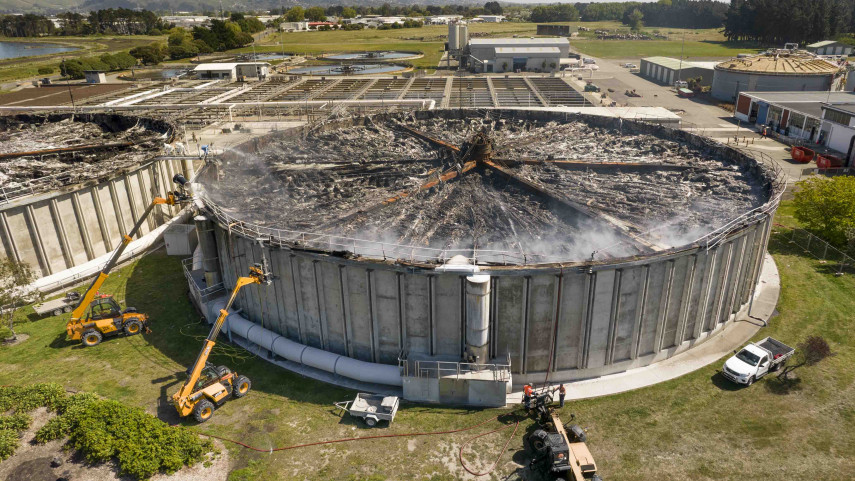
Fewer hot spots at fire-damaged wastewater treatment plant

Share this story
Fewer hot spots are smouldering at the Christchurch Wastewater Treatment Plant as around-the-clock efforts to cool down the fire-damaged trickling filters begin to pay-off.
Scaffolding towers have been erected around the massive concrete trickling filters, where the fire was concentrated, so that hoses can be used to dampen down the hot spots.
Since the 1 November blaze at the wastewater treatment plant in Bromley, Christchurch City Council has been also using misters to reduce the odour from the smouldering plastic media housed within the two trickling filters.
Council Head of Three Waters and Waste Helen Beaumont says those efforts are paying off, with the number of hot spots in the trickling filters reducing as each day goes by.
The fire, in addition to causing significant damage to the trickling filters, also destroyed the air extraction system for the initial wastewater screening and primary settlement tanks at the plant.
“We are working on an interim extraction system that we are aiming to have in place within the next three weeks. This will take the foul air from this part of the plant and direct it through the biofilters to reduce the odours,’’ says Ms Beaumont.
Changes are being made to the treatment processes at the plant to try to compensate for the loss of the trickling filters and to improve the quality of the final effluent. These changes should also reduce the potential for offensive odours being generated from the plant.
“The performance of the primary settlement tanks has been enhanced by the addition of poly aluminium chloride to settle more of the suspended solids and reduce the organic loading of the supernatant wastewater - the clear liquid from the top - that now bypasses the trickling filters and goes on to the secondary contact tanks. Monitoring shows this is working well.
“With these changes the secondary contact tanks are showing signs of recovery and the odours from this part of the plant have improved considerably over the past couple of days,’’ Ms Beaumont says.
“Without the trickling filters, the organics load of the wastewater being discharged into the oxidation ponds is higher so we have begun dosing the ponds with hydrogen peroxide. Hydrogen peroxide naturally breaks down into water and oxygen, saturating the wastewater with oxygen and reducing the biological oxygen demand – a key indicator of wastewater quality.
“The ponds look and smell much better following the hydrogen peroxide dosing and they are showing signs of recovery from the fire. The system is naturally adjusting to the high loadings it is receiving from the plant.’’
Ms Beaumont says the cause of the fire was still being investigated and a full damage assessment will not be able to happen until the material within the trickling filters, which is several metres deep, has been removed.
Consultants are being engaged to help work out the best way to remove the material.
“We appreciate the patience of the local community while we work on optimising the operation of the plant. The fire was an unfortunate event and we know that it has caused some odour issues for people living nearby,'' Ms Beaumont says.
